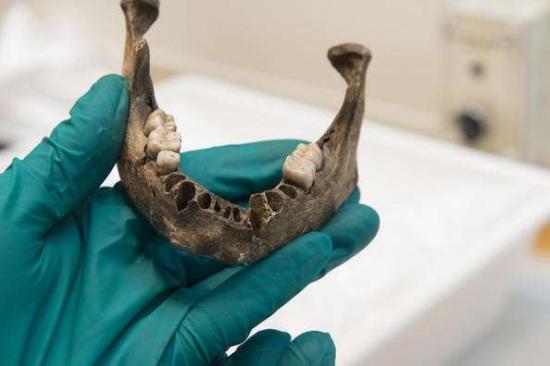University of Stavanger
Source - http://phys.org/news/2015-12-year-old-viste-boy-dna-analysis.html?
 Conservator Hege Hollund at the Museum of Archaeology, UiS, carefully moves the 8200 year old skull of the Viste boy.
Conservator Hege Hollund at the Museum of Archaeology, UiS, carefully moves the 8200 year old skull of the Viste boy.
A small piece of the skull of the 8000-year-old "Viste Boy" has now been sent to Sweden for DNA analysis. Scientists hope to learn more about early migration into Norway as well as clarify the skeleton's actual sex.
The "Viste Boy" lived 8200 years ago at Viste, outside Stavanger in southwestern Norway. He died at the young age of 15. Even though the remains are referred to as the Viste Boy, it is not certain that this is a male skeleton. Scientists had thought they were dealing with a male on the basis of older reports, but Viste Boy could well turn out to be Viste girl.
A small piece of the skull of this individual has now been sent from the Museum of Archaeology in Stavanger to Sweden for DNA analysis.
This is part of a wider Scandinavian project which seeks to understand prehistoric migration patterns into and around Scandinavia.
The two main theories are that people either came from the East, around the areas of what are now modern Sweden, Finland and Russia, or from Continental Europe to the south. As well as helping to provide an answer to this question, the DNA analysis on Viste Boy may, perhaps, also be able to say once and for all whether the skeleton is that of a boy or a girl.
Skeletons from several periods
As well as skeletal samples from Viste Boy, samples from three other skeletons were sent for analysis, including part of an upper arm that was found when carrying out excavations at Sømmevågen near Stavanger's Sola Airport last year. This is from an individual who lived 2000 years later than Viste Boy.
 Osteoarchaeologist Sean D. Denham at the the Museum of Archaeology in Stavanger takes a closer look at the skeleton of the Viste Boy.
Osteoarchaeologist Sean D. Denham at the the Museum of Archaeology in Stavanger takes a closer look at the skeleton of the Viste Boy.
If the DNA material from both skeletons has survived well enough to be analysed, scientists can see if there has been continuity in the population in Rogaland across the Mesolithic, or whether immigration occurred during that time.
"It's very exciting to have two Stone Age skeletons from areas that are as close to each other as Viste and Sømmevågen, but where there is approximately a 2000-year age difference", says osteoarchaeologist Sean D. Denham from the Museum of Archaeology.
The remains of several other human bones were found in the cave at Viste where Viste Boy was discovered. These belonged to an adult human. DNA analysis will also be carried on one of these, and perhaps it will be possible to say if there was any direct kinship between the people who were found in the cave.
A girl?
Osteoarchaeologist Sean D. Denham from the Museum of Archaeology recently had a closer look at the Viste Boy's skull and jawbone, and it is this which led him question the sex of the skeleton. He believes it may have some feminine features, but does not dare to draw any conclusions just yet.
Recent research has shown that the portion of the temporal bone of the Viste Boy's skull that has now been sent for analysis is the ideal bone material for recovering ancient DNA.
 The Viste Boys jawbone.
The Viste Boys jawbone.
The fragment was easy to remove from the skull, and because the scientists who will be carrying out the DNA analysis only need a small piece, the DNA lab will return the majority of the fragment to the museum undamaged.
Packed away
Scientists have now started calling the Viste Boy 'the Viste Individual' instead, in anticipation of a possible sex clarification by the Swedish laboratory. They recently packed away the skeleton in boxes, whilst a new exhibition space is built. It is in good condition, but Denham and conservator Hege Hollund will perform a more in depth assessment of the remains in November and, among other things, will take X-rays to document the different parts of the skeleton.
"It will be an exciting process, and the Viste Individual may require extra time as we know so little about its history since its discovery. Some preservation may be necessary, and we can actually see that one bone is not real. But we don't know why, how or when the copy was made", says Hollund.
The Viste Individual was on display in the Museum of Archaeology in Stavanger up until this spring. The skeleton will be on display again in spring 2016, when the museum will be opening a new exhibition called Møt menneskene (Meet the Humans). The public will get to meet many of their ancestors from Rogaland.